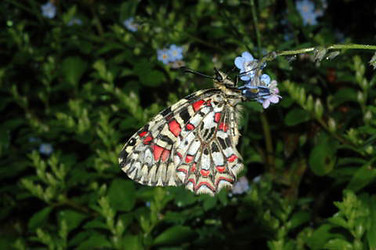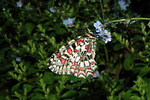Zerynthia
Vazrick Nazari and Frédéric Carbonell


This tree diagram shows the relationships between several groups of organisms.
The root of the current tree connects the organisms featured in this tree to their containing group and the rest of the Tree of Life. The basal branching point in the tree represents the ancestor of the other groups in the tree. This ancestor diversified over time into several descendent subgroups, which are represented as internal nodes and terminal taxa to the right.

You can click on the root to travel down the Tree of Life all the way to the root of all Life, and you can click on the names of descendent subgroups to travel up the Tree of Life all the way to individual species.
For more information on ToL tree formatting, please see Interpreting the Tree or Classification. To learn more about phylogenetic trees, please visit our Phylogenetic Biology pages.
close boxIntroduction
Zerynthia is a well studied genus with two readily recognized species, Z. rumina and Z. polyxena, distributed in southern and eastern Europe and northern Africa (Higgins and Riley, 1970). Both species have received attention from generations of European lepidopterists, and consequently, their life histories are well known. There are at least one or two available scientific names for nearly every population (Manley and Allcard, 1970). Zerynthia polyxena alone, for example, has more than 31 subspecies (Nardelli and Hirschfeld, 2002). Larvae of both species feed on Aristolochia, and their life history and ecology are also well known. Ford (1944a, 1944b) and Eisner (1974) proposed several morphological characters that can be useful in phylogenetic studies on Zerynthia and related genera. Intra- and interspecific hybridization between the two species has also been investigated by Descimon and Michel (1989) and Lux (1990).
Nomenclature
Although the name Parnalius Rafinesque, 1815 predated Zerynthia Ochsenheimer, 1816, it was proposed for suppression to conserve the name Zerynthia, by Kudrna and Ackery (1977) as well as Riley and Higgins (1977). The ICZN granted these proposals and Zerynthia Ochsenheimer, 1816, has been conserved by the suppresion of Parnalius Rafinesque, 1815 for the Law of Priority and not for the Law of Homonymy (ICZN, 1979: 102).
References
Descimon, H., Michel, F., 1989. Expériences d’hybridation intra- et interspécifiques dans le genre Zerynthia (Papilionidae). Relativité des critères mixiologiques de l’espèce. Nota Lepidopterologicae 12 (suppl.1): 28-31.
Eisner, C., 1974. Parnassiana Nova XLIX. Die Arten und Unterarten der Baroniidae, Teinopalpidae und Parnassiidae (Erster teil) (Lepidoptera). Zoologische Verhandelingen Uitgegeven door het Rijksmuseum van Natuurlijke Historie te Leiden, 135: 1-96.
Ford, E.B., 1944a. Studies on the chemistry of pigments in the Lepidoptera, with references to their bearing on systematics. 3. The red pigment of the Papilionidae. The Proceedings of the Royal Entomological Society of London 19: 92-106.
Ford, E.B., 1944b. Studies on the chemistry of pigments in the Lepidoptera, with references to their bearing on systematics. 4. The classification of the Papilionidae. The Transactions of the Royal Entomological Society of London 94: 201-223.
Higgins, L.G., Riley, N.D., 1970. A Field Guide to the Butterflies of Britain and Europe. Boston: Houghton Mifflin, 380 pp.
ICZN, 1979. Opinion 1134. Bulletin of Zoological Nomenclature 36: 102.
Kudrna, O., Ackery, P. R., 1977. [No title]. Bull. Zool. Nom. 33: 145.
Lux, C., 1990. Ethologie, systematique and ecologie de Zerynthia polyxena creusa Meigen dans les Alples-Maritimes (Fomes, variétés et aberrations du Papilionidae). Bulletin de la Societe Sciences Nat, 66: 9-17.
Manley, W.B.L., Allcard, H.G., 1970. A Field Guide to the Butterflies and Burnets of Spain. Hampton, Classey, 192 pp.
Nardelli, U., Hirschfeld, G., 2002. Abberations, formes et sous-especes de Zerynthia polyxena Denis and Schiffermüller, 1775 (Lepidoptera: Papilionidae). Lambillionea 102: 223-240.
Nazari, V., Zakharov, E.V., Sperling, F.A.H., 2007. Phylogeny, historical biogeography, and taxonomic ranking of Parnassiinae (Lepidoptera, Papilionidae) based on morphology and seven genes. Molecular Phylogenetics and Evolution, 42: 131-156.
Riley, N.D., Higgins, L.G., 1977. [No title]. Bull. Zool. Nom. 33: 145.
About This Page
Vazrick Nazari

Canadian National Collection of Insects, Arachnids and Nematodes, Ottawa, Canada
Correspondence regarding this page should be directed to Vazrick Nazari at and Frédéric Carbonell at
Page copyright © 2006 Vazrick Nazari and
 Page: Tree of Life
Zerynthia .
Authored by
Vazrick Nazari and Frédéric Carbonell.
The TEXT of this page is licensed under the
Creative Commons Attribution License - Version 3.0. Note that images and other media
featured on this page are each governed by their own license, and they may or may not be available
for reuse. Click on an image or a media link to access the media data window, which provides the
relevant licensing information. For the general terms and conditions of ToL material reuse and
redistribution, please see the Tree of Life Copyright
Policies.
Page: Tree of Life
Zerynthia .
Authored by
Vazrick Nazari and Frédéric Carbonell.
The TEXT of this page is licensed under the
Creative Commons Attribution License - Version 3.0. Note that images and other media
featured on this page are each governed by their own license, and they may or may not be available
for reuse. Click on an image or a media link to access the media data window, which provides the
relevant licensing information. For the general terms and conditions of ToL material reuse and
redistribution, please see the Tree of Life Copyright
Policies.
- First online 07 July 2006
- Content changed 07 July 2006
Citing this page:
Nazari, Vazrick and Frédéric Carbonell. 2006. Zerynthia . Version 07 July 2006 (under construction). http://tolweb.org/Zerynthia/65400/2006.07.07 in The Tree of Life Web Project, http://tolweb.org/








 Go to quick links
Go to quick search
Go to navigation for this section of the ToL site
Go to detailed links for the ToL site
Go to quick links
Go to quick search
Go to navigation for this section of the ToL site
Go to detailed links for the ToL site